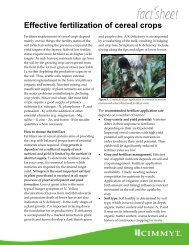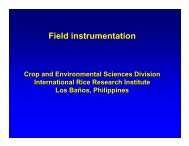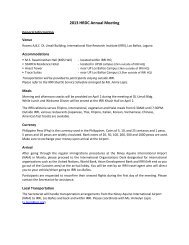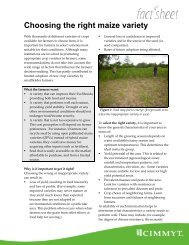Water management in irrigated rice - Rice Knowledge Bank ...
Water management in irrigated rice - Rice Knowledge Bank ...
Water management in irrigated rice - Rice Knowledge Bank ...
- No tags were found...
You also want an ePaper? Increase the reach of your titles
YUMPU automatically turns print PDFs into web optimized ePapers that Google loves.
tive to water deficit than cell enlargement.Leaf area expansion is reduced as soon asthe soil dries below saturation (tensionshigher than 1 kPa) <strong>in</strong> most cultivars, andwhen only about 30% of the available soilwater has been extracted <strong>in</strong> cultivars withaerobic adaptation (Lilley and Fukai 1994,Wopereis et al 1996).2. Closure of stomata, lead<strong>in</strong>g to reduced transpirationrate and reduced photosynthesis.Leaf stomata do not close immediately withdrought stress, however, and the crop keepson photosynthesiz<strong>in</strong>g for a certa<strong>in</strong> periodbefore stomata close. The assimilates arenot used for leaf growth or expansion (seepo<strong>in</strong>t 1), but are stored <strong>in</strong> the exist<strong>in</strong>g leaves,stems, and roots. When drought stress isrelieved, these assimilates may becomeavailable and lead to a flush <strong>in</strong> leaf growth.In the modern high-yield<strong>in</strong>g variety IR72,stomatal closure starts at soil water tensionsof 75 kPa (Wopereis et al 1996).3. Leaf roll<strong>in</strong>g, lead<strong>in</strong>g to a reduction <strong>in</strong> effectiveleaf area for light <strong>in</strong>terception. Leafroll<strong>in</strong>g <strong>in</strong> IR72 starts at soil water tensionsof 75 kPa (Wopereis et al 1996). Leaves unrollaga<strong>in</strong> when drought stress is relieved.4. Enhanced leaf senescence, lead<strong>in</strong>g to reducedcanopy photosynthesis. Enhancedsenescence <strong>in</strong> IR72 starts at soil water tensionsof 630 kPa (Wopereis et al 1996).5. Changes <strong>in</strong> assimilate partition<strong>in</strong>g. Rootsgrow more, at the expense of the shoot,dur<strong>in</strong>g vegetative development, whereaspartition<strong>in</strong>g of assimilates among variousshoot components is not affected. Deeperroots are effective for explor<strong>in</strong>g water stored<strong>in</strong> deeper soil layers.6. Reduced plant height (though it is not likelythat reduced plant height <strong>in</strong> itself will result<strong>in</strong> yield reduction).7. Delayed flower<strong>in</strong>g. Drought <strong>in</strong> the vegetativedevelopment stage can delay flower<strong>in</strong>gup to 3 to 4 weeks <strong>in</strong> photoperiod-<strong>in</strong>sensitivevarieties. The delay <strong>in</strong> flower<strong>in</strong>g islargest with drought early <strong>in</strong> the vegetativestage and is smaller when drought occurslater.8. Reduced tiller<strong>in</strong>g and tiller death. Droughtbefore or dur<strong>in</strong>g tiller<strong>in</strong>g reduces the numberof tillers and panicles per hill. If the droughtis relieved on time, and the source size(i.e., photosynthesiz<strong>in</strong>g leaves and stems)is sufficiently large, the reduced number oftillers/panicles may be compensated for byan <strong>in</strong>creased number of gra<strong>in</strong>s per panicleand/or by an <strong>in</strong>creased gra<strong>in</strong> weight.9. Reduced number of spikelets with droughtbetween panicle <strong>in</strong>itiation and flower<strong>in</strong>g,result<strong>in</strong>g <strong>in</strong> decreased number of gra<strong>in</strong>s perpanicle.10. <strong>Rice</strong> is very sensitive to reduced wateravailability <strong>in</strong> the period around flower<strong>in</strong>gas this greatly affects spikelet sterility (Cruzand O’Toole 1984, Ekanayake et al 1989).Increased spikelet sterility with drought atflower<strong>in</strong>g results <strong>in</strong> decreased percentageof filled spikelets and, therefore, decreasednumber of gra<strong>in</strong>s per panicle. Especially atanthesis, there is a short time span whenspikelet fertility is especially sensitive todrought.11. Decreased gra<strong>in</strong> weight with drought afterflower<strong>in</strong>g.The above processes appear roughly <strong>in</strong> orderof crop development and/or severity of drought,though numbers 2–4 also occur <strong>in</strong> the reproductivestage. Some effects lead to irreversible processesof yield reduction, such as numbers 4, 9, 10, and11, whereas others may be restored when droughtis relieved, such as numbers 2 and 3, and othersmay be compensated for by other effects later <strong>in</strong>the grow<strong>in</strong>g season, such as numbers 1, 2, and 8.Drought may also affect nutrient-use efficiency bythe crop s<strong>in</strong>ce water flow is the essential means ofnutrient transport. How yield is f<strong>in</strong>ally affected bydrought depends on its tim<strong>in</strong>g, severity, duration,and frequency of occurrence. The most sensitivestage of <strong>rice</strong> to drought is around flower<strong>in</strong>g.15


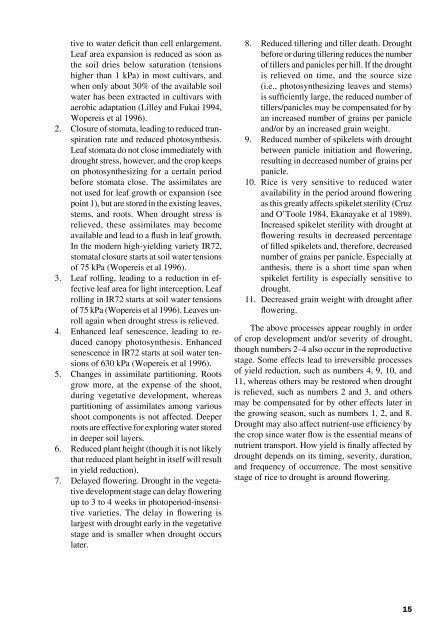


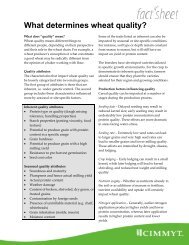

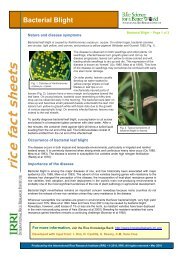

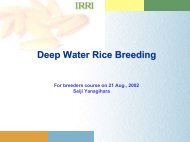
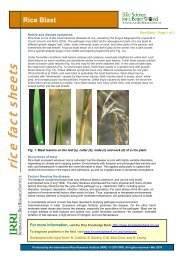
![International Standards' Organization â Rice Specification [ISO 7301]](https://img.yumpu.com/36696862/1/190x245/international-standards-organization-a-rice-specification-iso-7301.jpg?quality=85)

